

Social and Emotional Problems Related to Dyslexia. By: Michael Ryan, M.D. and International Dyslexia Association Do emotional disorders cause dyslexia?
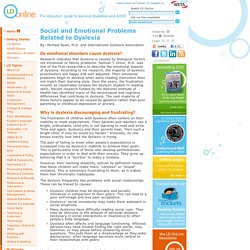
Research indicates that dyslexia is caused by biological factors not emotional or family problems. Samuel T. Orton, M.D. was one of the first researchers to describe the emotional aspects of dyslexia. According to his research, the majority of dyslexic preschoolers are happy and well adjusted. Why is dyslexia discouraging and frustrating? The frustration of children with dyslexia often centers on their inability to meet expectations. The pain of failing to meet other people's expectations is surpassed only by dyslexics' inability to achieve their goals. However, their learning disability, almost by definition means that these children will make many "careless" or "stupid" mistakes. The dyslexic frequently has problems with social relationships. Dyslexic children may be physically and socially immature in comparison to their peers. Finally, dyslexics' performance varies from day to day.
Perspectives of mothers of children with dyslectic difficulties concerning their encounters with school: a Swedish example. Psychological assessment and dyslexia: parents' perspectives. Neural dissociation of phonological and visual attention span disorders in developmental dyslexia: FMRI evidence from two case reports. A CNRS UMR 5105, 38040 Grenoble, Franceb Laboratoire de Psychologie et NeuroCognition, Université Pierre Mendès France, 38040 Grenoble Cedex 09, Francec Basque Center on Cognition Brain and Language, 20009 San Sebastian, Spaind INSERM U825, Pôle Neurosciences, Hôpital Purpan, 31059 Toulouse Cedex 03, Francee SFC Brain Imaging Research Center, University of Edinburgh, Edinburgh, EH4 2XU Scotland, United Kingdomf Institut Universitaire de France, 75005 Paris, Franceg INSERM U836/Université Joseph Fourier, Institut des Neurosciences, 38043 Grenoble Cedex 09, France Accepted 24 December 2011, Available online 28 January 2012 Choose an option to locate/access this article: Check if you have access through your login credentials or your institution Check access doi:10.1016/j.bandl.2011.12.015 Get rights and content Abstract A dissociation between phonological and visual attention (VA) span disorders has been reported in dyslexic children.
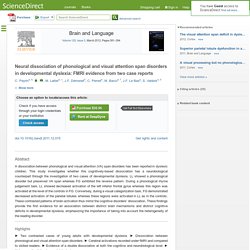
Highlights Keywords. Improvements in Spelling after QEEG-based Neurofeedback in Dyslexia: A Randomized Controlled Treatment Study. "Treatment of Dyslexia" John Stein 2013. Neuropsychological Treatment of Dyslexia: Does Type of Treatment Matter? Andrea Facoetti In this study, 123 children with a diagnosis of developmental dyslexia were assigned to different treatment groups, either variations of Bakker’s intervention program based on the balance model or a control, a specific reading training group.
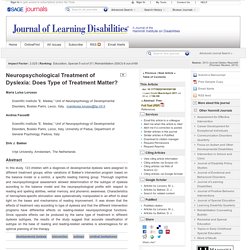
Thorough cognitive and neuropsychological assessment allowed determination of the subtype of dyslexia according to the balance model and the neuropsychological profile with respect to reading and spelling abilities, verbal memory, and phonemic awareness. Characteristics of hemisphere-specific stimulation were systematically manipulated in an effort to shed light on the bases and mechanisms of reading improvement. It was shown that the effects of treatment vary according to type of dyslexia and that the different intervention programs have differential effects on reading-related neuropsychological functions.
. © Hammill Institute on Disabilities 2011. Lateralized temporal order judgement in dyslexia. A lexical basis for N400 context effects: Evidence from MEG. Identifying and Teaching Children and Young People with Dyslexia and Literacy Difficulties. Intervention: Orton-Gillingham-based Strategies (Unbranded) - References. Temporal auditory processing: correlation with developmental dyslexia and cortical malformation. Processamento temporal auditivo: relação com dislexia do desenvolvimento e malformação cortical* Mirela BoscariolI, **; Catarina Abraão GuimarãesII; Simone Rocha de Vasconcellos HageIII; Fernando CendesIV; Marilisa Mantovani GuerreiroV IFonoaudióloga.
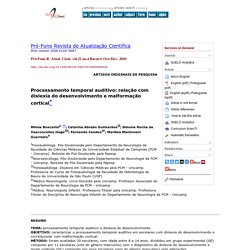
Pós-Doutoranda pelo Departamento de Neurologia da Faculdade de Ciências Médicas da Universidade Estadual de Campinas (FCM - Unicamp). Bolsista de Pós-Doutorado pela Fapesp IINeuropsicóloga. Pós-Doutoranda pelo Departamento de Neurologia da FCM - Unicamp. TEMA: processamento temporal auditivo e dislexia do desenvolvimento. Palavras-Chave: Dislexia; Audição; Criança. Introdução Processamento temporal auditivo é a habilidade do sistema auditivo em processar as mudanças do sinal acústico que ocorrem ao longo do tempo e a habilidade em processar eventos acústicos transitórios1.
Há relatos de que os distúrbios de linguagem e aprendizagem podem ocorrer em presença de malformações do desenvolvimento cortical. Método Resultados Discussão Conclusão. A tractography study in dyslexia: neuroanatomic correlates of orthographic, phonological and speech processing. Diffusion tensor imaging tractography is a structural magnetic resonance imaging technique allowing reconstruction and assessment of the integrity of three dimensional white matter tracts, as indexed by their fractional anisotropy.
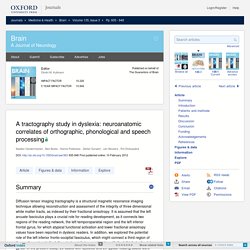
It is assumed that the left arcuate fasciculus plays a crucial role for reading development, as it connects two regions of the reading network, the left temporoparietal region and the left inferior frontal gyrus, for which atypical functional activation and lower fractional anisotropy values have been reported in dyslexic readers. In addition, we explored the potential role of the left inferior fronto-occipital fasciculus, which might connect a third region of the reading network, the left ventral occipitotemporal region with the left inferior frontal gyrus.
Neural correlates of temporal auditory processing in developmental dyslexia during German vowel length discrimination: An fMRI study. A Department of Psychology II, Faculty of Social Sciences, University of Kaiserslautern, Erwin-Schrödinger-Straße, Gebäude 57, D-67663 Kaiserslautern, Germanyb Transfer Centre for Neuroscience and Learning (ZNL), University of Ulm, Beim Alten Fritz 2, D-89075 Ulm, Germanyc Department of Child and Adolescent Psychiatry and Psychotherapy, University of Munich, Nussbaumstr. 5a, D-80336 Munich, Germanyd Department of Neurology, University of Ulm, Oberer Eselsberg 45, D-89081 Ulm, Germany Accepted 4 December 2011, Available online 28 February 2012 Choose an option to locate/access this article: Check if you have access through your login credentials or your institution Check access doi:10.1016/j.bandl.2011.12.003 Get rights and content Abstract.
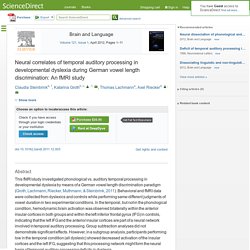
Scotopic sensitivity syndrome - Wikipedia, the free encyclopedia. Scotopic sensitivity syndrome (SSS), also known as Visual Stress, Irlen Syndrome, and Asfedia, is a condition relating to the interaction of the central nervous system and the eyes at a physiological level with light.
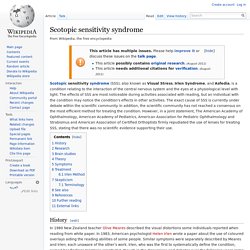
The effects of SSS are most noticeable during activities associated with reading, but an individual with the condition may notice the condition's effects in other activities. The exact cause of SSS is currently under debate within the scientific community. In addition, the scientific community has not reached a consensus on the most efficient method for treating the condition. Yale Center For Dyslexia & Creativity. Ferrer E, Shaywitz BA, Holahan JM, Marchione K, Shaywitz SE.

Uncoupling of Reading and IQ Over Time: Empirical Evidence for a Definition of Dyslexia. Psychol Sci. 2010 Jan;21(1):93-101. Epub 2009 Nov 23. PubMed PMID: 20424029. Theories of dyslexia - Wikipedia, the free encyclopedia. The primary symptoms of dyslexia were first identified by Oswald Berkhan in 1881.[1] The term 'dyslexia' was coined in 1887 by Rudolf Berlin,[2] an ophthalmologist practicing in Stuttgart, Germany.[3] Since then generations of researchers have been investigating what dyslexia is and trying to identify the biological causes.

(See History section of the Dyslexia article.) The theories of the etiology of dyslexia have and are evolving with each new generation of dyslexia researchers, and the more recent theories of dyslexia tend to enhance one or more of the older theories as understanding of the nature of dyslexia evolves. Theories should not be viewed as competing, but as attempting to explain the underlying causes of a similar set of symptoms from a variety of research perspectives and background.[4][5] Cerebellar theory[edit] The cerebellar theory asserts that a mildly dysfunctional cerebellum can cause dyslexia.
Evolutionary hypothesis[edit] Magnocellular theory[edit] Visual theory[edit] Orthographies and dyslexia - Wikipedia, the free encyclopedia. Dyslexia is a complex, lifelong disorder involving difficulty in learning to read or interpret words, letters and other symbols.
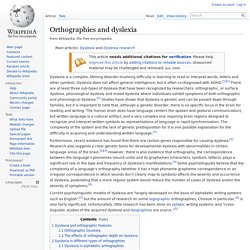
Dyslexia does not affect general intelligence, but is often co-diagnosed with ADHD.[1][1] There are at least three sub-types of dyslexia that have been recognized by researchers: orthographic, or surface dyslexia, phonological dyslexia and mixed dyslexia where individuals exhibit symptoms of both orthographic and phonological dyslexia.[2] Studies have shown that dyslexia is genetic and can be passed down through families, but it is important to note that, although a genetic disorder, there is no specific locus in the brain for reading and writing. The human brain does have language centers (for spoken and gestural communication), but written language is a cultural artifact, and a very complex one requiring brain regions designed to recognize and interpret written symbols as representations of language in rapid synchronization.
History of developmental dyslexia - Wikipedia, the free encyclopedia. Identified by Oswald Berkhan in 1881,[1] the term 'dyslexia' was later coined in 1887 by Rudolf Berlin,[2] an ophthalmologist practicing in Stuttgart, Germany.[3] He used the term to refer to a case of a young boy who had a severe impairment in learning to read and write in spite of showing typical intellectual and physical abilities in all other respects. In 1896, W. Pringle Morgan, a British physician, from Seaford, East Sussex published a description of a reading-specific learning disorder in a report to the British Medical Journal titled "Congenital Word Blindness". This described the case of a 14-year-old boy who had not yet learned to read, yet showed normal intelligence and was generally adept at other activities typical of children of that age.[4] 1900-1950[edit] In 1925 Samuel T. Low-level defective processing of non-verbal sounds in dyslexic children. On the relationship between dynamic visual and auditory processing and literacy skills; results from a large primary-school study.
The effects of audiobooks on the psychosocial adjustment of pre-adolescents and adolescents with dyslexia. Reading comprehension and reading related abilities in adolescents with reading disabilities and attention-deficit/hyperactivity disorder. Non-word repetition and literacy in Dutch children at-risk of dyslexia and children with SLI: results of the follow-up study. Dyslexia research must prompt swift response to pupils at risk - Article - TES Connect. Last Updated:11 May, 2008Section:Article Scarcely a month goes by without a news report about dyslexia. So it is no surprise that, despite advances in scientific understanding of this relatively common learning difficulty, it remains controversial. It is time to take stock and use our knowledge to guide policy and practice. It is vital to dispel the myth that dyslexia is a "category" of disorder. The main symptom (in English) is poor reading accuracy or decoding skills. We now know that the underlying weakness that causes poor decoding is difficulty with the sound structure of speech (phonological awareness).
This difficulty can vary from mild to severe, so dyslexia (like obesity) is properly viewed as a "dimension". Research at York university and elsewhere shows that children who enter school with mild to moderate difficulties in phonological awareness respond well to targeted work such as Early Literacy Support. Dyslexia is not a static condition that a person does or does not have. Dyslexia Online. Coping with academic failure, a study of Dutch children with dyslexia. Auditory perceptual processing in people with reading and oral language impairments: current issues and recommendations. Auditory stream biasing in children with reading impairments. Can solving of wordchains be explained by phonological skills alone?